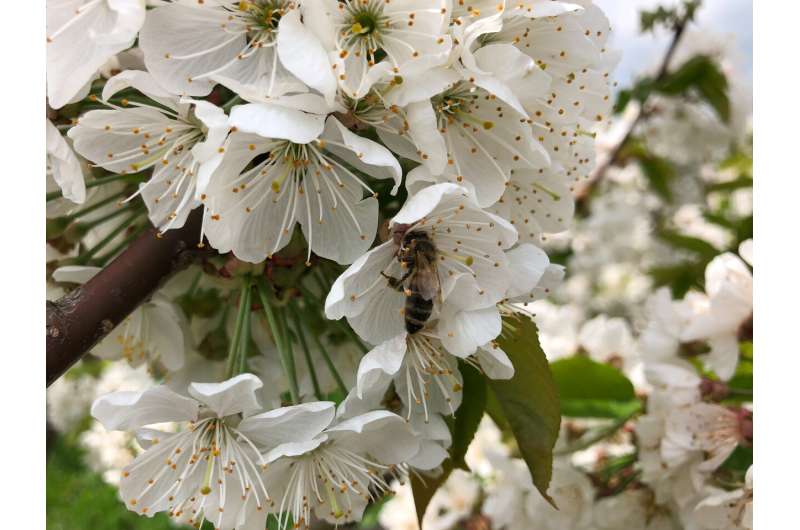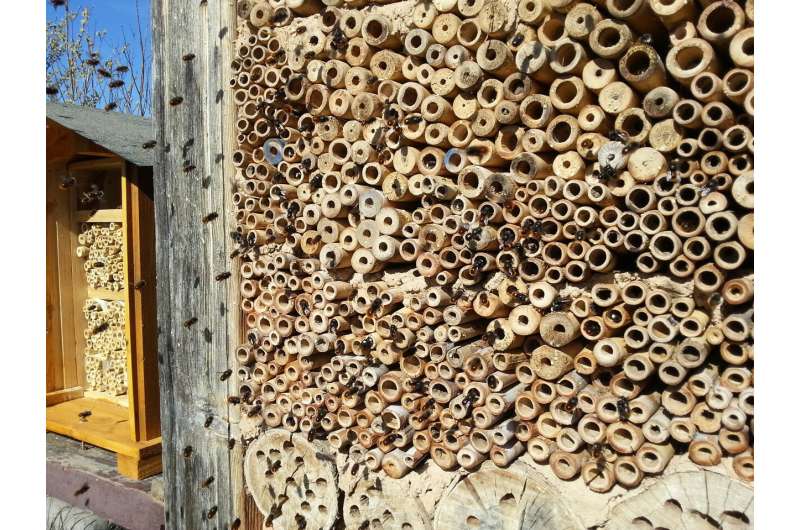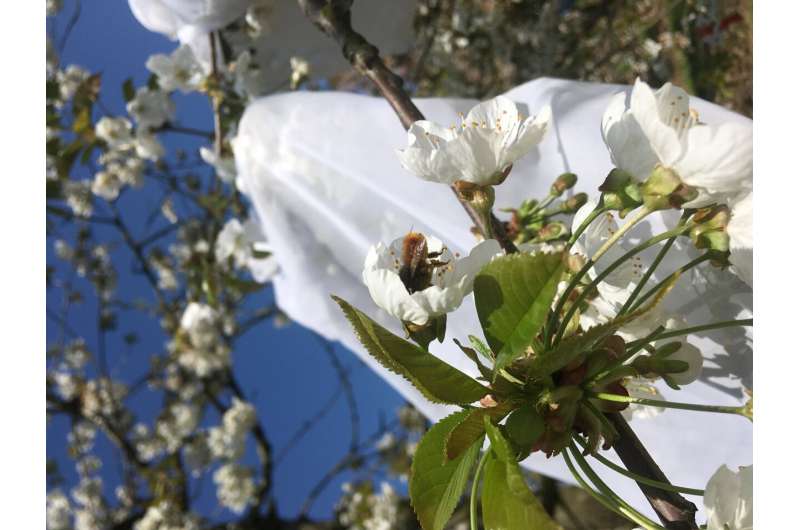This article has been reviewed according to Science X's editorial process and policies. Editors have highlighted the following attributes while ensuring the content's credibility:
fact-checked
peer-reviewed publication
trusted source
proofread
Pollination by more than one bee species found to improve cherry harvest

To obtain the biggest cherry harvest, trees should be pollinated by both honey bees and mason bees. A new study led by a researcher at the University of Gothenburg shows yet another benefit of biodiversity.
Like many other fruit trees, most sweet cherry cultivars depend on cross-pollination to produce their fruit. This means that there need to be several different cultivars of sweet cherry trees in an orchard for the bees to transport pollen from one to another.
"Sweet cherry trees are usually planted in alternate rows of different cultivars. In some cases, you can put different cultivars in the same row, but this can make the harvesting logistics tricky. In other words, the bees have to fly from one row of trees to the next to ensure that the trees set fruit," says Julia Osterman, a biologist at the University of Gothenburg and lead author of the study.
The paper, "Mason bees and honey bees synergistically enhance fruit set in sweet cherry orchards", has been published in the journal Ecology and Evolution.
Two bee species produce a synergy effect
Working with German researcher colleagues at Martin Luther University Halle-Wittenberg, Julia Osterman found that if trees were pollinated by more than one bee species, they produced more cherries. The researchers observed bees in a total of 17 cherry orchards in eastern Germany. Some growers used honey bees in hives as pollinators, while others used wild mason bees. Some orchards used both species to different extents. The researchers noticed a synergy effect in those orchards in which both species of bee were present.

"It had an impact on the sweet cherry fruit set. The orchards with honey bees and lots of mason bees could have cherries on up to 70% of the blossom. In orchards with only honey bees or only mason bees as pollinators the rate could be as low as 20%," says Julia Osterman.
Many growers were already using two species of bees, often as a back-up if the weather was too cold for the honey bees when the cherry trees were in bloom, as cherries flower early. Honey bees only become active once the temperature is above 12°C, but mason bees can cope with lower temperatures. The sharp increase in fruiting occurred when both species were active. The researchers are now speculating on the reasons for this.
Bamboo sticks as nest material
"One theory is that the presence of mason bees affects the foraging behavior of honey bees," says Julia Osterman. "This disturbs them and so they change rows more often, resulting in more cross-pollination. But all we know at the moment is that interaction between the bees produces a synergy effect."
Of course, this is valuable data for cherry growers who can attract wild mason bees to their orchards by providing good nest material.

"Mason bees are solitary and don't make honey in honeycombs like honey bees," Julia Osterman explains.
"They are more focused on collecting pollen to feed their offspring. They like to crawl into tube-shaped spaces where they can lay their eggs. Fruit growers can encourage mason bees to nest in their orchards by placing bamboo or wood with holes drilled in it at the site. However, it only seems to work up to a certain limit, after which you won't attract any more mason bees, no matter how much nest material you bring in."
Similar results have been observed in almond orchards and Julia Osterman's next step will be to investigate whether this synergy effect applies to other fruit trees, as well as trying to determine exactly how the two bee species are affecting each other.
The study was conducted in Saxony-Anhalt and Thuringia in Germany in spring 2020 with researchers from Martin Luther University Halle-Wittenberg and a research institute in Erfurt.
More information: Julia Osterman et al, Mason bees and honey bees synergistically enhance fruit set in sweet cherry orchards, Ecology and Evolution (2023). DOI: 10.1002/ece3.10289
Journal information: Ecology and Evolution
Provided by University of Gothenburg





















